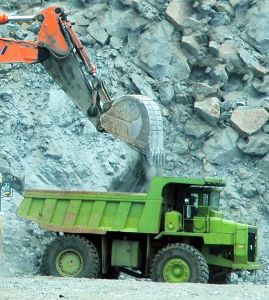The U.S. Department of Labor’s Occupational Safety and Health Administration filed a petition last week intended to reduce the instance of chronic respiratory illness and cancer among U.S. workers. The plan seeks to lower worker exposure to crystalline silica, a toxic particle that kills hundreds of workers and sickens thousands each year. OSHA’s proposed rule includes two separate standards-one for general industry and maritime employees and one for employees in the construction industry.
 Currently, OSHA enforces a rule dated 40 years to regulate permissible exposure limits (PEL) for silica exposure, which is inconsistent between different work industries. The proposed rule would bring these PELs up to workplace standards and into the 21st century; greatly lowering the amount of silica exposure to workers. OSHA predicts that this new mandated policy would save nearly 700 lives per year and prevent 1,600 new cases of silicosis annually.
Currently, OSHA enforces a rule dated 40 years to regulate permissible exposure limits (PEL) for silica exposure, which is inconsistent between different work industries. The proposed rule would bring these PELs up to workplace standards and into the 21st century; greatly lowering the amount of silica exposure to workers. OSHA predicts that this new mandated policy would save nearly 700 lives per year and prevent 1,600 new cases of silicosis annually.
What is Crystalline Silica and Where Is It Found?
Crystalline silica is a micro component of soil, sand, granite, and other types of materials. Quartz, cristobalite, and tridymite are three types of crystalline silica. When materials containing crystalline silica are grinded, cut, or drilled the particles become respirable-sized. Crystalline silica is considered a human carcinogen, and can cause a variety of respiratory issues including lung cancer, silicosis, chronic obstructive pulmonary disease and kidney disease. When inhaled, crystalline silica causes scar tissue formation on the lungs, and debilitates the lungs’ ability to absorb oxygen. Silicosis, aside from being incurable, can lead to other infectious diseases and debilitating conditions including tuberculosis.
Silica exposure is a threat to nearly 2 million workers in the United States and is most common in construction jobs including abrasive blasting, foundry work, stone cutting, rock drilling, quarry work, tunneling, as well as maritime work. The most common exposures to workers in construction occur during abrasive blasting with sand to remove rust and paint from bridges, and other surfaces, as well as concrete mixing, concrete drilling, brick cutting, and rock drilling.
General industry employees are often exposed to crystalline silica particles from asphalt paving jobs, painting industries, cement and ceramic manufacturing, as well as soap and glass manufacturing.
How Can Employees and Employers Prevent Crystalline Silica Exposure?
Employees and employers can help prevent crystalline silica exposure by:
• Replacing materials containing crystalline silica materials with safer substitutes, if and whenever possible.
• Use protective equipment and engineering whenever possible such as exhaust ventilation systems to reduce PEL exposures.
• Use all available work practices to control dust exposure such as water sprays.
• Wear OSHA certified respirators that form a tight seal to the face whenever necessary so as to prevent inhalation of silica particles.
• Wear disposable or washable work clothes and shower if facilities are possible after heavy exposure to silica dust. Vacuum dust from clothes and change into clean clothing before leaving job sites to as to prevent tracking of dust into car or at home.
• Participate in training, exposure monitoring, and health screening and surveillance programs to monitor any adverse health effects caused by silica exposure.
• Be aware of any jobs that create silica dust and known the ways to prevent inhalation.
• Do not eat, drink, smoke or apply cosmetics in areas where crystalline silica dust is present. Wash your hands and face outside of dusty environments.
We’ll Protect Your Rights
Under Massachusetts and OSHA law, employers are liable for ensuring that all of his or her employees are working in safe environments and that the workplace is free of hazards that can cause injury, illness, or death. Employers are also responsible for making sure employees have the proper training to perform their jobs, and are properly trained to prevent injuries to themselves as well as others.
When a person becomes injured or ill as a result of his or her job, he or she may be entitled to filing a workers’ compensation claim. According to Massachusetts workers’ compensation law, workers are supposed to be guaranteed benefits if they become ill or are injured on the job-even if it was the worker who caused the accident. In Massachusetts, workers’ compensation benefits typically include coverage of medical costs, disability payments, 60% of your average income (or greater if your injury resulted in permanent disability), compensation for permanent disfigurement or scars, retraining, and death benefits for immediate family members if the worker was killed on the job. In return for this “guarantee” workers are not allowed to sue his or her employee for any work-related injuries.
If you or a loved one was injured while on the job or developed a life-threatening disease, call one of the seasoned Boston Workers’ Compensation Attorneys at the law offices of Altman & Altman for a free initial consultation, to discuss your workers’ compensation claim. Our team has nearly 50 years of experience handling workers’ compensation cases and we have successfully recovered millions of dollars for our clients who have been the victim of workplace injury. We manage each case with the highest level of professionalism and we are always available to answer any questions you have about your case.
 Massachusetts Workers' Compensation Lawyer Blog
Massachusetts Workers' Compensation Lawyer Blog









